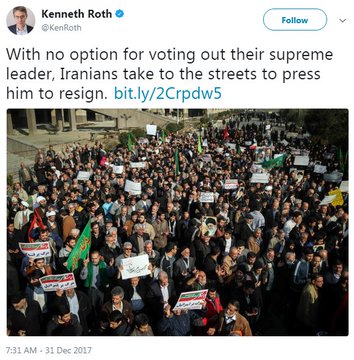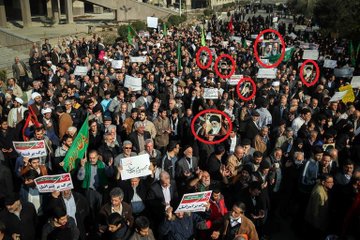Sputnik- The Iranian protests revealed the split both within the Iranian elites, and with society. President Hassan Rouhani still faces resistance from the country's ultra-conservatives. It is likely that the unrest was prompted by domestic economic difficulties, rather than by the actions of external players.
The protests�which erupted on�December 28, 2017, in�Iran's major cities, including Tehran, Mashhad, Isfahan and Rash immediately became the focus of�special attention from�mass media, prompting theories of�foreign interference�or even a new revolution in�the country.�Sputnik Persian�has taken a closer look at�the problem.
Why Now?
The timing of�the event raises questions: What exactly happened between�the end of�December 2017 and the beginning of�January 2018 that triggered the public discontent? And why did rallies kick off�in Mashhad?
In December, Tehran undertook a number of�economic measures which may have been the last straw. These measures led to�the hike in�fuel prices, which resulted in�the price increase for�almost all types of�goods. Meanwhile, an epidemic of�avian influenza killed 15 million chickens, further inflating the price for�eggs and chicken�� the most popular and affordable foods for�Iranians.
That same month, Iranian President Hassan Rouhani proposed a new budget at�the Iranian Majlis, the country's parliament, which envisaged the abolishment of�some subsidies for�the population. The new budget also suggested an increase in�taxes, including on�leaving the country, which will see a nearly threefold increase, from $21 to $61. Simultaneously, Tehran will boost military expenditure, including the maintenance of�its armed forces abroad.
[caption id="" align="alignnone" width="581"]
 Iranian soldiers prepare to launch a Hawk surface-to-air missile during military maneuvers at an undisclosed location[/caption]
Iranian soldiers prepare to launch a Hawk surface-to-air missile during military maneuvers at an undisclosed location[/caption]Hassan Rouhani Could be the Main Target
Although the Rouhani government has done much to pull the country back from economic crisis, including signing the Joint Comprehensive Plan of Action (JCPOA) with the P5+1 countries and the EU in 2015, the president is not "omnipotent." Rouhani is second to the country's supreme leader Ayatollah Ali Khamenei in terms of power, therefore part of the president's economic plans and measures have yet to be implemented.
Despite the 4-5 percent GDP growth under�Rouhani, the unemployment rate in�the country remains at�12.4 percent, and youth unemployment at�28.8 percent. It was the youth who became the driving force for�the recent protests.
In addition, Iran's military political activities abroad�� in�Iraq, Syria and Yemen�� required considerable expenditures on�the part of�Tehran. In 2013, the Iranian government allocated $15 billion for�Syria, which allowed Bashar al-Assad to�fulfill his social obligations and finance his army. From 2015 onward, Iran's economic assistance to�Damascus has amounted to $8-9 billion per annum.
As a result, Rouhani was forced to�take unpopular measures, causing dissatisfaction among�different social layers in�the country.
[caption id="" align="alignnone" width="591"]
 In this photo taken by an individual not employed by the Associated Press and obtained by the AP outside Iran, university students attend a protest inside Tehran University while anti-riot Iranian police prevent them to join other protestors, in Tehran, Iran, Saturday, Dec. 30, 2017[/caption]
In this photo taken by an individual not employed by the Associated Press and obtained by the AP outside Iran, university students attend a protest inside Tehran University while anti-riot Iranian police prevent them to join other protestors, in Tehran, Iran, Saturday, Dec. 30, 2017[/caption]Why Did Protests Kick Off in�Mashhad
It is no coincidence that protests began in�Mashhad: Being a sacred city for�Shiites, it is also the mainstay of�ultraconservatives and their leaders Ebrahim Raisi�� Rouhani's main rival in�the 2017 elections�� and Shiite Islamic cleric Ahmad Alamolhoda, who opposes President Rouhani and his policies.
According to�some reports, it was Alamolhoda who called upon�the residents of�Mashhad to�take to�the streets against�Rouhani. Yet another leader of�the conservative opposition, former Iranian President Mahmoud Ahmadinejad, joined his associates. Unconfirmed reports say that�Ahmadinejad was arrested�in�the western Iranian city of�Bushehr for�contributing to�the unrest. Iranian authorities and the media have not commented on�the issue yet.
However, it appears that the situation did not develop according to�the plans of�the initiators. Economic slogans and demands were quickly changed to�political ones, criticizing the Islamic regime in�the country, as�well as�its domestic and foreign policies. The wave of�protests engulfed the whole of�Iran.
What Were the Major Social Drivers of�the Protests?
Young people make up�more than�60 percent of�the country's population. They are well-educated and use the Internet. It seems that many of�them feel uncomfortable with�the Islamic ideological pressure that regulates almost all aspects of�everyday life. Out of�80 million people, 48 million Iranians have smartphones and 40 million use Telegram messenger. They are well aware of�what is happening in�the world.
However, besides�pro-Western youths, the nation-wide protests also involved conservative Muslims and representatives of�the poorest strata. The representatives of�various political trends signaled their discontent with�the Iranian leadership. Still, the protesters often expressed contradictory views.
[caption id="" align="alignnone" width="602"]
 People protest in Tehran, Iran December 30, 2017 in this picture obtained from social media[/caption]
People protest in Tehran, Iran December 30, 2017 in this picture obtained from social media[/caption]At the same time, the Iranian middle class�� Rouhani's voters�� did not support the protests and opposed the nation-wide rallies. While the demonstrations involved various social and political groups, including those from�the highest echelons of�power, they could be divided into�two camps: liberal reformers and radical conservatives.
Perhaps everyone was interested in�using the situation in�their political interests over�the course of�the protests. The reformer Rouhani can tell his opponents that they are hampering reforms, so people taking to�the streets are in�favor of�change. Conservative radicals may answer that, although Rouhani has been in�power since�2013, he has done nothing to�improve people's lives.
Ken Roth also shares a pic from a pro-Khamenei rally and suggest it's an anti-Khamenei rally even though it's pretty obvious.. pic.twitter.com/RuhCF9AdhG
11:11 AM - Dec 31, 2017


What Did the Iran Protests Indicate?
1.�The protests appeared to�be largely triggered by�internal economic and political causes.
2.�It's unlikely that they were provoked by�external forces. Foreign influence was limited to�anti-Iranian propaganda in�the mainstream media�and Internet and statements from�some foreign leaders directed against�Tehran.
3.�The protests translated into�neither a revolution, nor a general uprising: Although demonstrations engulfed the country's major cities, the number of�protesters (from 40,000 to�400,000, depending on�the estimates) was insignificant, given the fact that the country's population amounts to�80 million.
4.�The Iranian protesters did not have a unified goal, program or leaders.
5.�Iranian authorities did not exercise tough or excessive measures while handling the situation.
6.�Tehran plans to�carry out�a thorough investigation of�the events and consider the demands of�the protesters. It was reported that the municipality of�Tehran has already approved the idea of�creating a specialized park for�public protests, modeled on�London's Hyde Park.
7.�The events indicated a split within�the Iranian elites, as�well as�the country's society. However, it depends on�the leadership of�the Islamic Republic of�Iran (IRI), its domestic and foreign policies whether protests will be resumed.
Since late December 2017, about�3,700 people have been detained during�the protests, while at�least 20 people were killed. According to�Interior Minister Abdolreza Rahmani Fazli, about�42,000 Iranians took part in�the rallies.
The views expressed in�this article do not necessarily reflect the official position of�Sputnik.










